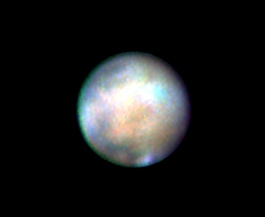

This tri-color (RGB) CCD image was obtained by Gregory Terrance, an experienced astroimager, on April 15, 1997 (Ls=104.6, De=25.51, Dia.=12.94"; the Face on Mars owes back taxes but who is going to collect?) at 03:10 UT (CM=126.8; average of red (03:12 UT, 0.15 sec. exposure), green (03:00 UT, 0.22 sec.), and blue (03:20 UT, 0.30") images) using a 16-inch (41-cm) f/5 Newtonian reflector, at an EFR of f/25, coupled to a Celestron PixCel 255 CCD camera. The NPC appears to be surrounded by a dark (3/10) collar consisting of Abalos, Ierne, and Lemuria. Mare Acidalium and Mare Boreum appear dark (3/10) along the Np. limb with a dusky (4/10) Nilokeras projecting from Mare Acidalium's Sf. border with Idaeus Fons and Achillis Fons extending north and south from it, respectively. Nerigos and Scandia appear dusky to dull (4-5/10) S. of the NPC whereas Tempe appears dull to bright (5-7/10). Panchaia appears dark to dusky (3-4/10). The Propontis Complex (Propontis I and II as well as Castorius Lacus; at times including Euxinus Lacus) appears dusky to dark (3-4/10) towards the f. limb. Ganges appears dusky (4/10) and bifurcated (or geminated (doubled), a phenomena first reported by the famous Italian astronomer Giovanni Schiaparelli in 1881) whereas Candor and Ophir appear very bright (8/10) along it's f. border. Melas Lacus and Tithonius Lacus appear as dark (3/10) condensations apparently connected to a dark (3/10) Aurorae Sinus on the p. limb. Solis Lacus appears as a dark (3/10), elongated albedo feature along the Sp. limb. Sinus Sirenum appears to be obscured by a bright (7/10) veil (its northern border may barely be discerned). A very bright (8/10) equatorial cloud band (ECB) appears to extend from the Chryse-Xanthe region on the p. limb across Ganges, Candor, Tharsis and finally Mesogaea.
(Legend: N.=north, S.=south, p.=preceding, f.=following,
Np.=north-preceding, Nf.=north-following, Sp.=south-preceding, Sf.=south-following,
MLH=morning limb haze, ELH=evening limb haze, and SLH=southern limb haze)